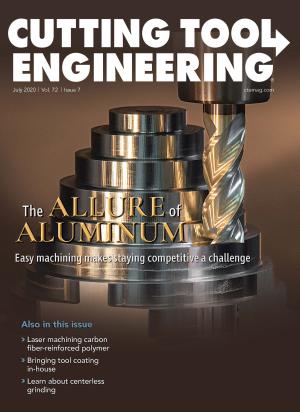Dear Doc: We ID-grind steel bearing rings with a CBN wheel running at 8,500 rpm and a workpiece running at 120 rpm. We get about 70 chatter marks around the inner circumference of the ring. I’m trying to figure out if the chatter is coming from an untrue or imbalanced wheel or just basic, self-excited chatter. Is my thinking right on this? And is there a way to tell?
The Doc replies: Your thinking is right, and there’s a simple test to see where the chatter is coming from. First, something is happening at a frequency of 140 chatters per second, and we have to figure out what that “something” is. [Chatter frequency in Hz = number of chatter marks per workpiece revolution × workpiece rpm / 60 = 70 × 120 / 60 = 140.]
Chatter has many possible sources, but let’s start with the two most likely: 1) an out-of-balance or out-of-true wheel or 2) self-excited chatter — that is, the wheel/spindle bouncing up and down at its natural frequency or the workpiece/toolholder bouncing up and down at its natural frequency. An out-of-balance or out-of-true wheel chatters at the wheel rpm, so 8,500 rpm = 142 revolutions per second. If one of those natural frequencies is about 140 Hz and the workpiece is running at 120 rpm, that will give around 70 chatters on the workpiece. [Number of chatter marks per workpiece revolution = chatter frequency in Hz × 60 / workpiece rpm, or 140 × 60 / 120 = 70.]
Since your wheel rpm and potential natural frequency are very close, how can we know if the chatter is coming from an out-of-balance/out-of-true wheel or the self-excited natural frequency? Simply slow down the wheel rpm and see if the chatter marks become farther apart (with fewer chatters per revolution). If they do, that points toward out-of-balance or out-of-true chatter. If they stay the same, that points toward self-excited chatter.
Why is that? With self-excited chatter, the wheel/spindle (or workpiece/toolholder) likes to bounce up and down at its natural frequency, and that’s independent of wheel speed. If the spindle likes to bounce up and down at 140 bounces per second, the spindle will do that at all rpm: 8,500 rpm, 7,500 rpm, 9,500 rpm, etc.
But if it’s out-of-balance or out-of-true chatter, slowing down the wheel rpm will give a lower chatter frequency and hence a bigger distance between chatter marks. (7,500 rpm = 125 revolutions per second, which now gives 62.5 chatters per revolution instead of 70.) [125 × 60 / 120 = 62.5.]
That’s a quick test to point you in the right direction of the cause of chatter. Maybe you immediately can pinpoint it, or maybe you’ll need a vibrations expert with multiple accelerometers and four days of complex computer simulation. That’s because chatter is notoriously complex. Frederick Winslow Taylor (1856-1915), the godfather of production engineering, said in 1906, “Chatter is the most obscure and delicate of all problems facing the machinist.” It’s still true today. Chatter is tough.
Related Glossary Terms
- chatter
chatter
Condition of vibration involving the machine, workpiece and cutting tool. Once this condition arises, it is often self-sustaining until the problem is corrected. Chatter can be identified when lines or grooves appear at regular intervals in the workpiece. These lines or grooves are caused by the teeth of the cutter as they vibrate in and out of the workpiece and their spacing depends on the frequency of vibration.
- cubic boron nitride ( CBN)
cubic boron nitride ( CBN)
Crystal manufactured from boron nitride under high pressure and temperature. Used to cut hard-to-machine ferrous and nickel-base materials up to 70 HRC. Second hardest material after diamond. See superabrasive tools.


